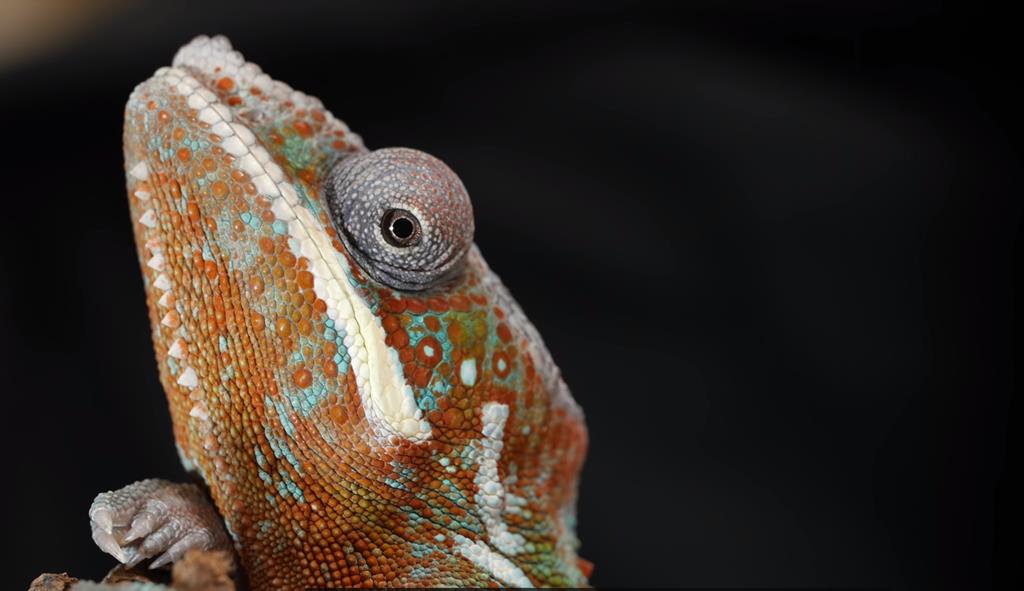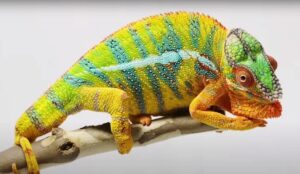To increase humidity in your chameleon cage, regularly mist the enclosure and incorporate live plants. Use a humidifier or set up a drip system for consistent moisture.
Creating an ideal environment for a chameleon involves maintaining proper humidity levels, which are crucial for their well-being. Chameleons, being reptiles of tropical origin, thrive in conditions that replicate their natural habitat. Ensuring the right level of humidity supports their hydration and sheds process, and aids in respiratory health.
Pet owners need to strike a balance between dryness and excessive moisture to prevent health issues and stress in these sensitive creatures. Implementing practical strategies like misting, live planting, and technological aids can alleviate the challenges of humidity control. With attentive care, your chameleon’s habitat can become a lush and comfortable microcosm, conducive to their active and healthy lifestyle.
The Importance Of Humidity For Chameleons
Chameleons are unique creatures that thrive in specific environments. Their skin requires moisture for good health. A chameleon cage must have the right humidity levels. This helps these colorful animals stay hydrated through their skin. Too little or too much moisture can harm them.
Health Benefits Of Proper Humidity Levels
Proper humidity levels are key for a chameleon’s well-being. A balance keeps their skin healthy and supple.
- Aids in shedding: Chameleons shed their skin. Good humidity helps in this natural process.
- Prevents dehydration: Chameleons absorb water through their skin. Adequate air moisture keeps them hydrated.
- Supports respiratory health: Proper moisture levels ensure that the chameleon’s respiratory system functions well.
Risks Involved With Inadequate Humidity
Inadequate humidity can lead to health issues. Know what risks your pet faces in a dry cage.
- Shedding problems: Without enough moisture, shedding becomes hard. This can lead to skin infections.
- Dehydration: A dry environment can cause dehydration. This is not immediately obvious but it’s serious.
- Respiratory issues: Low humidity can make breathing difficult for chameleons. Over time, this can damage their lungs.
Assessing Your Current Cage Setup
Before diving into creating a tropical haven for your chameleon, take a moment to evaluate your enclosure. Ensuring proper humidity is crucial for your pet’s health. A suitable environment helps prevent stress and common respiratory issues. It starts with understanding the current state of your chameleon’s home.
Tools For Measuring Humidity
Knowing the exact humidity level makes all the difference. A reliable digital hygrometer is essential.
Look for one that gives accurate readings and includes minimum and maximum memory functions.
This will keep track of humidity changes over time. Here are some must-have tools:
- Digital hygrometer – For precise measurements
- Thermo-hygrometer – Monitors both temperature and humidity
- Hydrostat – Regulates humidity levels automatically
Identifying Humidity Deficiencies
A quick check with the hygrometer can reveal if the humidity falls below the ideal range of 50-70%.
Observe for signs like dry skin or your chameleon gasping for air.
Frequent misting schedules or a dripper setup might be necessary.
Spotting these inadequacies early on allows you to take timely measures for maintaining optimal humidity.
Note any drafts or airflow issues that could cause rapid moisture loss.
Seal any gaps in the cage if needed.
Plants also play a crucial role in retaining moisture; hence, including live plants may help increase ambient humidity.
Humidifying Techniques For Chameleon Enclosures
Chameleons thrive in humid environments, mirroring their natural tropical habitat. Maintaining proper humidity in chameleon enclosures is crucial for their health. Let’s dive into some effective humidifying techniques to create the perfect environment for your colorful companion.
Daily Misting Routines
Consistent misting keeps the enclosure humid and mimics natural rainfall. Here are some tips:
- Manual Misting: Use a spray bottle to mist the cage at least twice daily.
- Duration: Spray for about 30 seconds to a minute each session.
- Best Times: Misting early morning and late evening aligns with natural dew.
Automated misting systems can take over if you’re away or prefer convenience.
Using Foggers And Humidifiers
For a more hands-off approach, consider these devices:
| Device Type | Benefits | Usage Tips |
|---|---|---|
| Foggers | Increases air moisture and visual appeal of the cage | Use during the night when temperatures drop |
| Humidifiers | Provides consistent humidity levels | Integrate with a hygrostat for optimal control |
Align fogger and humidifier usage with your chameleon’s specific humidity needs.
Vegetation And Decor That Promote Humidity
Vegetation and Decor That Promote Humidity are essential for a chameleon’s health. These elements play a key role in mimicking their natural habitat. This creates a comfortable space for your chameleon to thrive. Proper vegetation and water features are vital for maintaining humidity levels. They help in keeping your pet happy and hydrated.
Best Plants For A Humid Habitat
Choosing the right plants is crucial for a humid environment inside your chameleon’s cage. They release moisture through a process called transpiration. This adds to the overall humidity. Plants also provide your chameleon with hiding spots. This makes them feel safe and secure.
- Ficus – Great for releasing moisture into the air
- Pothos – Easy to grow and excellent at increasing humidity
- Dracaena – Tall plants that offer both shade and humidity
- Boston Ferns – Humidity-loving plants that thrive in similar conditions as chameleons
These plants are not only functional but also enhance the aesthetic appeal of your setup. They create a lush, vibrant environment that chameleons adore.
Adding Water Features
Water features act as natural humidifiers. These include dripping systems, waterfalls, or foggers. They all boost the cage’s moisture level. Be sure to keep the water clean to prevent bacteria growth.
- Drip Systems – Simulate raindrops and increase humidity
- Mini Waterfalls – Adds movement and constant moisture to the air
- Foggers – Create a mist that chameleons love and raise humidity effectively
Use a hygrometer to monitor the humidity level. Make sure it stays within the recommended range for your chameleon’s species.
Climate Control For Chameleon Health
Maintaining the right climate in a chameleon cage is crucial. Chameleons thrive in specific humidity conditions. Let’s explore how to manage this delicate environment for your pet’s health.
Temperature And Humidity: Striking The Balance
Chameleons need a balanced habitat. Heat supports their digestion and activity. Humidity keeps their skin healthy. Follow these tips:
- Use a hygrometer to monitor levels.
- Mist twice a day to boost moisture.
- Consider automated humidifiers for consistency.
Remember, the ideal range is 50-70% humidity with temperatures between 72-80°F during the day and 62-70°F at night.
When To Adjust Humidity Levels Seasonally
Season changes mean humidity tweaks. Let’s break it down:
- Winter often brings dry air. Increase misting. Add a humidifier if needed.
- In summer, decrease misting. Ensure good ventilation to prevent mold.
Adjust your chameleon’s environment with the changing seasons. This ensures year-round well-being for your pet.
Maintenance And Monitoring
Keeping your chameleon happy involves more than just setting up their cage once. It’s like a mini ecosystem that needs regular care. Maintaining humidity is crucial for your chameleon’s health. Let’s look at ways to keep the moisture at perfect levels.
Regular Cleaning Schedule
Cleanliness is key in a humidity-controlled environment. A dirty cage can affect moisture levels and make your chameleon sick.
- Remove uneaten food daily to prevent mold and bacteria.
- Wipe down surfaces weekly to keep the habitat fresh.
- Check for stagnant water which can be a breeding ground for microbes.
- Change substrate as needed to keep the bottom layer dry and comfy.
Use natural cleaners like vinegar to avoid harsh chemicals. A consistent cleaning schedule prevents humidity swings.
Keeping A Humidity Log
Tracking changes is a must. You can identify patterns and adjust the care routine.
Add more rows as needed| Date | Time | Humidity Level |
|---|---|---|
| April 1 | Morning | 75% |
| April 1 | Evening | 65% |
A simple notebook works, but a digital spreadsheet is even better.
Record the humidity twice a day. Adjust the misting frequency or intensity accordingly. Remember to note any changes in room conditions like heating or air conditioning.
Frequently Asked Questions Of How Do I Keep The Humidity Up In My Chameleon Cage?
How Do I Raise The Humidity In My Chameleon Enclosure?
To raise humidity in a chameleon enclosure, mist the habitat regularly, add live plants, use a humidifier, set up a dripping system, and maintain water bowls.
How Do I Increase The Humidity In My Screen Cage?
To increase humidity in a screen cage, regularly mist the enclosure, add a water feature like a fountain or waterfall, incorporate live plants, use a substrate that retains moisture, or install a humidifier.
How Do I Raise The Humidity In My Reptile Tank?
To raise humidity in your reptile tank, mist the enclosure regularly, add a water dish, or use a reptile humidifier. Incorporate live plants and a moisture-retaining substrate to help maintain higher humidity levels. Monitor with a hygrometer to ensure optimal conditions.
What Is The Best Humidity Level For A Chameleon?
The ideal humidity level for a chameleon ranges between 50% and 70%. Maintaining this range supports their health and mimics their natural habitat.
Conclusion
Maintaining proper humidity is crucial for your chameleon’s health. By utilizing misting systems, live plants, and hygrometers, you create an ideal environment. Remember, consistency is key. Review the tips shared, and watch your pet thrive in their lush, moisture-rich habitat.
Happy herping!


